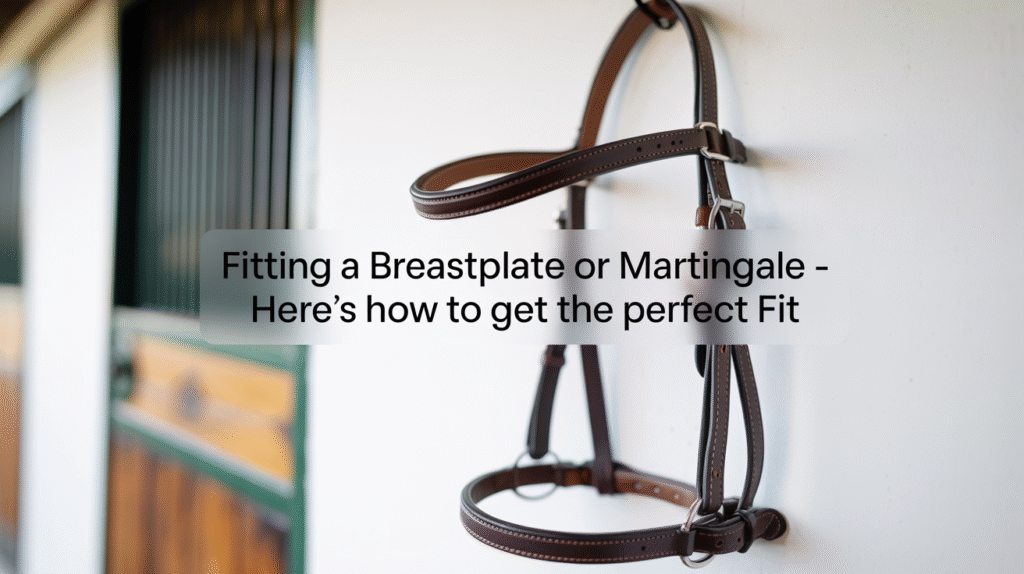The best way to fit a breastplate or martingale is by adjusting it so it supports saddle stability without restricting your horse’s movement or breathing. These tack accessories play crucial roles in both performance and safety, particularly in disciplines like jumping, eventing, and cross-country. However, a poorly fitted breastplate or martingale can do more harm than good, causing chafing, breathing issues, or interfering with stride.

Here’s a complete guide on how to properly fit and use breastplates and martingales for optimal performance and comfort.
Why Proper Fit of Breastplates and Martingales Matters
A good fit ensures the equipment enhances, rather than hinders, your horse’s performance.
Prevents Saddle Slippage
Especially useful for active riding and uneven terrain.
- Keeps the saddle from sliding backward during jumps or fast turns.
- Provides stability during cross-country, trail rides, or roping.
Supports Rider Control
Martingales help correct head carriage in specific training or performance contexts.
- Assists with downward transitions and frame control.
- Limits excessive head tossing without forcing unnatural positions.
Types of Breastplates and Martingales
Understanding each style helps you choose the right one for your needs.
Hunting Breastplate
Common in jumping disciplines and general riding.
- Attaches to the D-rings of the saddle and girth.
- Keeps the saddle in place with minimal restriction.
Five-Point Breastplate
Offers maximum stability, often used in eventing.
- Connects to saddle D-rings, girth, and billets.
- Distributes pressure across more contact points for better balance.
Western Breast Collar
Used primarily in roping and trail riding.
- Connects to the cinch and saddle rigging.
- Designed for freedom of shoulder movement.
Standing Martingale
Prevents the horse from raising its head too high.
- Attaches from the girth to the noseband.
- Used in show jumping and hunting.
Running Martingale
More adjustable and allows natural movement.
- Forked straps guide the reins through rings.
- Common in eventing and training for controlled head carriage.
How to Fit a Breastplate Correctly
Whether it’s a hunting or five-point style, proper fitting is essential for safety and comfort.
Adjust the Shoulder Straps
Should rest over the shoulders without pulling or sagging.
- Must allow full shoulder rotation and forward motion.
- Should lie flat without twisting or bunching.
Check Chest Fit
The central strap should sit comfortably in the middle of the chest.
- Should not pull tight when the horse stretches forward.
- Avoid pressure over the windpipe or sternum.
Secure Girth Attachments
Attach straps to the girth snugly but without restricting breathing.
- Allow a few fingers’ width of slack to ensure comfort.
- Monitor the area for rubbing or irritation after riding.
How to Fit a Martingale Properly
Martingales must support control without interfering with the bit or reins.
Standing Martingale Fit
Shouldn’t restrict movement when the horse’s head is in a neutral position.
- Should reach the noseband with a few inches of slack when reins are slack.
- Avoid tightening to force head position unnaturally.
Running Martingale Fit
Should only engage when the horse lifts its head excessively.
- Rings should reach the reins without creating tension when the horse’s head is in the proper frame.
- Use rein stops to prevent the rings from getting caught on the bit or rein ends.
Tips for Ensuring Comfort and Safety
Follow these best practices to protect your horse and improve tack performance.
Use Padding Where Needed
Padded straps can prevent chafing and pressure points.
- Especially useful for horses with sensitive skin or high withers.
- Look for fleece or gel-lined versions for long rides.
Regularly Check for Fit Changes
Tack fit can change with muscle development or weight fluctuation.
- Reassess every few weeks during training periods.
- Replace worn or stretched straps promptly.
FAQs
Here are some questions and answers about fitting a breastplate or martingale:
How tight should a breastplate be?
A breastplate should be snug enough to prevent saddle slippage but loose enough to allow free shoulder movement. You should be able to fit a flat hand between the chest strap and the horse.
Can I use a martingale and breastplate together?
Yes, many eventing or show jumpers use both together. Ensure each piece is fitted independently and doesn’t interfere with the other.
What’s the difference between standing and running martingales?
Standing martingales restrict upward head movement consistently, while running martingales only engage when the horse lifts its head too high. Running martingales are generally considered more humane and adjustable.
Should young or green horses wear a martingale?
In training, running martingales can help guide head position gently. However, they should only be used under experienced supervision to avoid creating resistance.
How do I know if the fit is wrong?
If you notice chafing, pinched skin, shortened stride, or resistance when bridling or saddling, the fit may be too tight or incorrectly adjusted.
Fitting a breastplate or martingale correctly ensures your tack works with your horse—not against them. Whether you’re riding for sport, training, or trail, understanding how these tools function and how to fit them properly will help keep your horse comfortable, responsive, and confident.